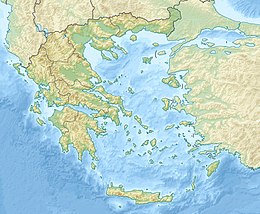
Back Naxos ALS ناكسوس Arabic ناكسوس ARZ Наксос Bulgarian Naxos Catalan Nísos Náxos CEB ناکسوس CKB Naxos (ostrov) Czech Naxos Welsh Naxos (ø) Danish
Native name: Νάξος | |
|---|---|
 Port of Naxos (city) | |
| Geography | |
| Coordinates | 37°05′15″N 25°24′14″E / 37.08750°N 25.40389°E |
| Archipelago | Cyclades |
| Area | 430 km2 (170 sq mi) |
| Highest elevation | 1,003 m (3291 ft) |
| Highest point | Mt. Zeus |
| Administration | |
Greece | |
| Region | South Aegean |
| Regional unit | Naxos |
| Capital city | Naxos (city) |
| Demographics | |
| Demonym | Naxiot |
| Population | 18,904 (2011) |
| Pop. density | 44/km2 (114/sq mi) |
Naxos (/ˈnæksɒs, -soʊs/; Greek: Νάξος, pronounced [ˈnaksos]) is a Greek island belonging to the Cyclades island group. It is the largest island in the group. It was an important centre during the Bronze Age Cycladic Culture and in the Ancient Greek Archaic Period. The island is famous as a source of emery, a rock rich in corundum, which until modern times was one of the best abrasives available.[1]
The largest town and capital of the island is Chora or Naxos City, with 8,897 inhabitants (2021 census). The main villages are Filoti, Apiranthos, Vivlos, Agios Arsenios, Koronos and Glynado.
- ^ https://www.naxos.gr/emery-mines/?lang=en (viewed 01/07/2023).
